The Mystery of Rennes-le-Château, Bérenger Saunière, and the Priory of Sion Treasure
Explore the Devil’s treasure and the secrets of Bérenger Saunière, Rennes-le-Château, and Henri Boudet, who allegedly hid clues to a great secret. Rennes-le-Château is a small village in the south of France that has long been shrouded in mystery and intrigue. The enigmatic priests associated with the village, Bérenger Saunière (abbé Saunière was the local priest), Abbé Henri Boudet (Curé of Rennes-le-Bains), and Abbé Antoine Bigou, have all contributed to the mystique surrounding the area around Rennes-le-Château.
Their alleged involvement in a treasure linked to the church at Rennes-le-Château and the presence of cryptic messages and symbols have all added to the allure of tourists visiting this area of France. The myth that the parish priest of Rennes-le-Château Bérenger Saunière found something of immense value, such as lost or buried treasure, such as the treasure of Blanche of Castile, still fascinates thousands of people today.
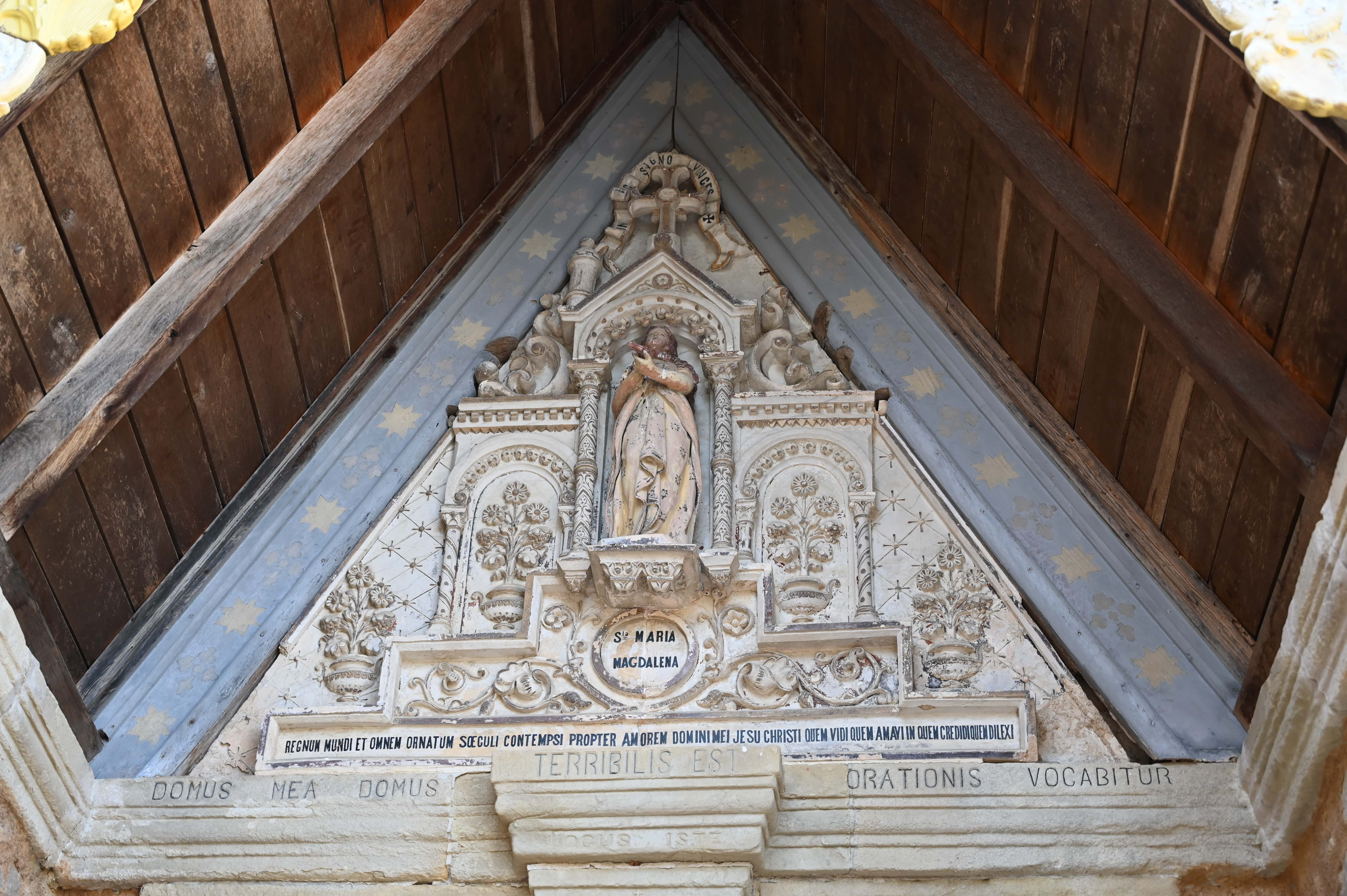
The legend of Rennes-le-Château is deeply entwined with tales of hidden treasures, secret societies, and enigmatic priests. The village has captured the imagination of many due to its rumoured associations with the Knights Templar and allegations of conspiracy theories. This article delves into some of these mysteries to shed light on the intriguing history of Rennes-le-Château and the enigmatic characters associated with it.
As we explore the secrets of Rennes-le-Château, we will unravel the compelling sagas and legends surrounding elusive treasure and priests such as Bérenger Saunière, Abbé Henri Boudet (Curé of Rennes-le-Bains), and Abbé Antoine Bigou. The sudden wealth relating to Bérenger Saunière, his eccentricities, the mysterious women in his life, and cryptic messages have piqued curiosity for generations.
The Legend of Rennes-le-Château
Rennes-le-Château is a small hilltop village in the Languedoc region of southern France. It gained global notoriety due to the enigmatic tales surrounding its purported hidden treasure and the mysterious priests associated with it. The legend of Rennes-le-Château has fascinated historians, conspiracy theorists, and treasure hunters for decades, leading to numerous books, documentaries, and even a Dan Brown novel, The Da Vinci Code, inspired by the intriguing stories.
At the heart of this legend is the story of Bérenger Saunière, a priest who suddenly acquired immense wealth in the late 19th century under mysterious circumstances. The source of his newfound riches remains a subject of fascination and speculation, with theories ranging from the hidden treasure of the Temple of Soloman and Templar treasures to secret parchments hidden within the church’s renovations.
Rennes-les-Bains
The village also gained attention due to Abbé Henri Boudet (Curé of Rennes-les-Bains) and Abbé Antoine Bigou (Curé of Rennes-le-Château 1796-1792), two other priests who were linked to various esoteric theories and codes related to Rennes-le-Château.
The mystery of Rennes extends beyond just the priests’ sudden wealth, encompassing cryptic symbols, supposed ancient parchments and speculations about their potential meanings. The area’s ties to various historical events, such as crusades and religious movements, have only added to its allure. To this day, tourists flock to Rennes-le-Château in hopes of uncovering its secrets or simply indulging in the manic atmosphere that surrounds it.
| Rennes-Le-Château | Mystery |
|---|---|
| Hidden Treasure | Speculated sources of wealth include Templar treasures or secret parchments. |
| Enigmatic Priests | Bérenger Saunière, Abbé Henri Boudet, and Abbé Antoine Bigou are connected to various esoteric theories. |
| Cryptic Symbols | The area is known for its mysterious symbols and their potential meanings linked to historical events. |
Bérenger Saunière
François Bérenger Saunière, the priest of Rennes-le-Château, was an enigmatic and controversial figure in French history. Bérenger saunière was born on April 11 1852, and lived until January 22 1917. He was a Roman Catholic priest who served in the tiny village of Rennes-le-Chateau, nestled in the picturesque Aude region of southern France. Despite his relatively short life, he left an indelible mark on the region and the world at large.
The mysterious wealth and treasure of Rennes-le-Château
One of the most captivating aspects of the Rennes-le-Château mystery is the sudden wealth that befell Bérenger Saunière, the enigmatic priest who served at the local church. In 1885, Bérenger Saunière began an extensive renovation of the church, which sparked speculation about the source of his newfound fortune. The renovations were extravagant and mysterious, leading many to think it was probable that Bérenger Saunière made a discovery and came into possession of a significant treasure.
The puzzling transactions
Bérenger Saunière’s sudden wealth was accompanied by peculiar financial transactions that only added to the intrigue. It is said that he paid for expensive renovations in cash and made unusual purchases, raising questions about where he obtained such a substantial amount of money. These transactions have fueled speculation about hidden treasures or secret knowledge that Saunière may have encountered as a priest in Rennes-le-Château.
The alleged discovery of a tomb and a tombstone
What Saunière may have found in the area around Rennes-le-Château is drenched in endless myths. What led to his supposed unexplained wealth is now well documented. Some past theories suggested that he unearthed ancient artefacts or documents containing valuable information during his church renovations. Others speculated that he discovered hidden treasure or esoteric knowledge related to the area’s history. The mysterious circumstances surrounding his sudden affluence turned him into a central figure in the enduring enigma of Rennes-le-Château. Later in the second part of this article, we discuss more ideas as to what Saunière found, such as the discovery of a tomb and a tombstone.
Abbé Henri Boudet
One of the most intriguing aspects of Boudet’s connection to the Rennes-le-Château mystery is his authorship of a book titled La Vraie Langue Celtique et le Cromleck de Rennes-les-Bains (The True Celtic Language and the Cromlech of Rennes-les-Bains).

The map in the picture is from his book and was drawn by Boudet’s brother, Jean-Baptiste-Edmond Boudet. Some researchers at Templarkey are editing a book in regards to Boudet’s book, which will be published in late 2025 or early 2026. Proponents of various conspiracy theories have cited this work as evidence that Boudet possessed esoteric knowledge about the region, including its rumoured hidden treasure. Intriguingly, within the grounds of the Church of Saint Mary Magdalene in Rennes-le-Château lies an enigmatic tombstone that is believed to be linked to Abbé Henri Boudet via other local priests Abbé Antoine Bigou and Abbé Jean Vie.
Carved with cryptic inscriptions and symbols, this tombstone has fueled speculation about its potential connection to the alleged treasure or other mysterious secrets. Some researchers believe deciphering these inscriptions could be the key to unlocking the enigma of Rennes-le-Château. Abbé Henri Boudet’s influence on the legends and mysteries surrounding Rennes-le-Château is undeniable.
| Abbé Henri Boudet | Eccentric Priest |
|---|---|
| Born: 1837 | Known for scholarly pursuits and unconventional beliefs |
| Authored La Vraie Langue Celtique et le Cromleck de Rennes-les-Bains | Cited as evidence for esoteric knowledge about Rennes-le-Château |
| A tombstone at the Church of Saint Mary Magdalene linked to him | Fueled speculation about its potential connection to alleged treasure or other mysterious secrets. |
Marie Dénarnaud
Marie Dénarnaud was a crucial figure in the life of the enigmatic priest Bérenger Saunière and has become an integral part of the mystery surrounding Rennes-le-Château. Described by some as a beautiful and mysterious woman, Marie worked as a housekeeper for Saunière. Her presence in the small village has sparked numerous theories and speculations about her true identity and connection to the secrets of Rennes-le-Château.
The myth of Rennes-le-Château involving Noël Corbu
After the death of Saunière in 1917, he was survived by his servant and confidant, some have said mistress, Marie Dénarnaud. Due to his death, there was no income, and Marie found it difficult to maintain the small villa, so it was sold to Noël Corbu in 1946. French property law is very different from English and American, and a property can be sold when an elderly owner or a family member is still living there. These older people or family members would be allowed to stay there until their deaths.
After Marie died in 1955, Noël Corbu opened a hotel and restaurant on the property and, in 1956 gave a serialised interview in a regional newspaper. He claimed Marie had told him that Saunière had found Blanche de Castile’s treasure, which had accumulated to pay the ransom of Saint Louis. According to him, most of it was still hidden in the area. He also claimed Saunière found some mysterious parchments of enormous value.
The story may be accurate, but it’s also possible that Marie made it all up to have a more secure retirement. It is more likely that Corbu, a published novelist, made it all up to promote his hotel and business. Assuming a story of hidden treasure would attract visitors, Corbu was correct, and within no time, this story spread like wildfire; people arrived equipped with shovels and rushed to the cemetery of Rennes-le-Château to dig up the graves.
Did Berenger Sauniere Create Clues? On a station of the cross / the Devil / Masonic Pavement / Blue Apples in Rennes?
The following section includes more tantalising topics relating to the mystery of abbé Saunière and the holy places Saunière allegedly ordered to be modified to suit a hidden treasure theory.
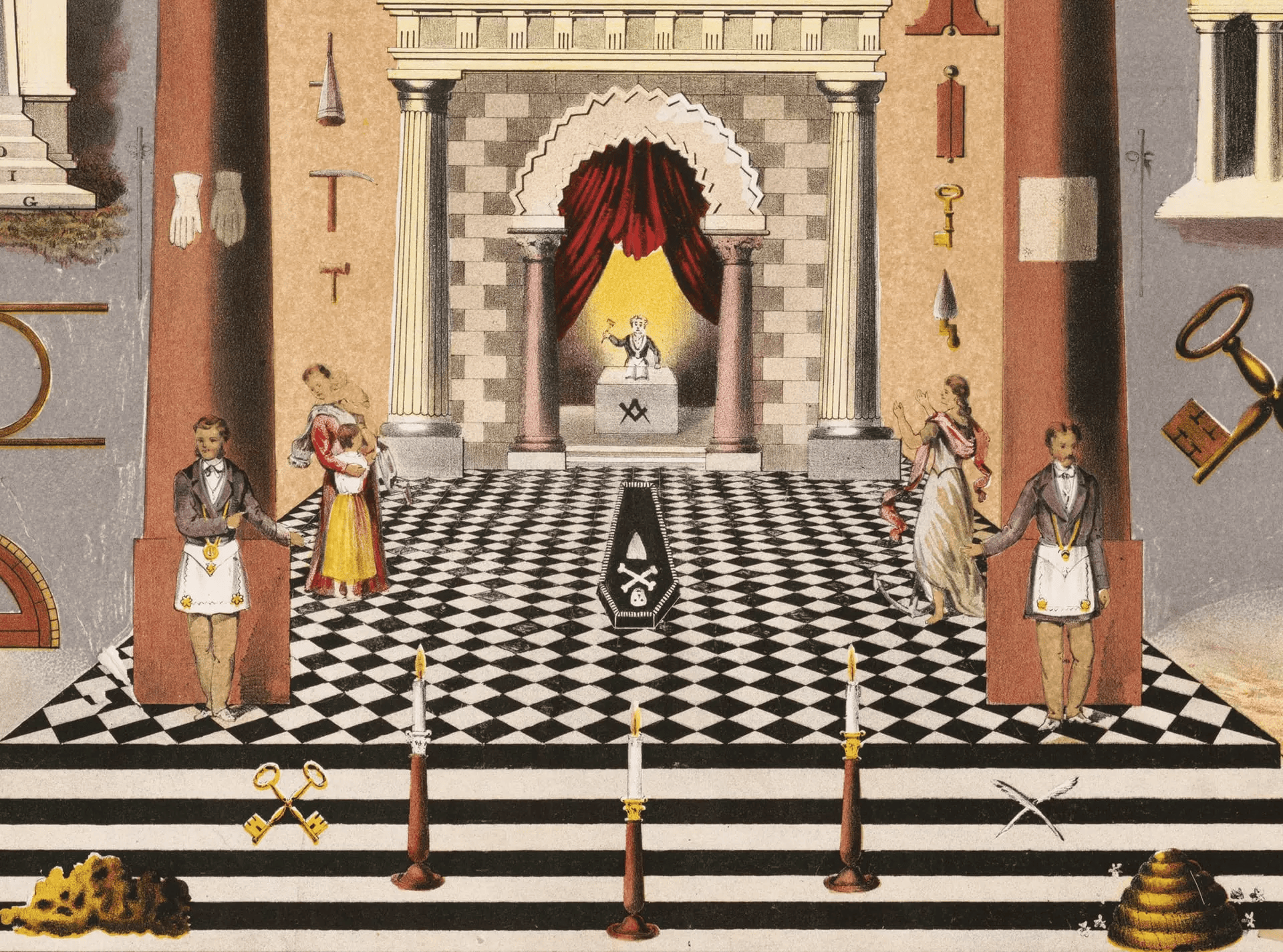
Église Sainte Marie-Madeleine/Church of Saint Mary Magdalene
Originally, this church was dedicated to the Virgin Mary (Mary the Mother), like small chapels/churches. However, Penitent Chapels were dedicated to Mary Magdalene due to the theological sense of the Penitent Mary, i.e., Mary Magdalene and Mary the Egyptian. These other small chapels/churches, such as the church at Rennes-le-Château, were then re-dedicated to Mary Magdalene, with the larger churches/Cathedrals keeping the Virgin Mary (Mary the Mother) dedication, such as Notre-Dame, French for “Our Lady”.
Examples:
- Basilica of Notre-Dame de Fourvière, Lyon
- Cathédrale of Notre Dame, Amiens
- Cathédrale Notre-Dame de Bayeux
- Cathédrale Notre-Dame de Chartres
- Cathédrale Notre-Dame de Laon
- Cathédrale Notre-Dame de Rouen
- Cathédrale Notre-Dame-de-Strasbourg
- Notre-Dame-de-Bon-Secours Chapel of Dieppe
- Church of Notre-Dame of Dijon
- Chapel of Notre Dame des Anges
- Collegiate Church of Notre-Dame, Melun
- Église Notre Dame de l’Assomption, Metz
- Église Notre-Dame la Grande, Poitiers
- Notre-Dame de la Garde, Marseille
- Notre Dame de l’Assomption, les Saintes, Terre-de-Haut
- Notre-Dame de Guebwiller
- Notre-Dame de Nice
- Notre-Dame de Paris
- Notre-Dame de Reims
- Notre Dame des Cyclistes, Labastide-d’Armagnac
- Notre Dame du Haut, Ronchamp
- Church of Notre-Dame, Villeneuve-sur-Yonne
- Church of Notre-Dame de Dives-sur-Merent
Were the rebuilding works extravagant?
The cost of the rebuilding work, such as the gardens, church, villa, an orangery, library and the Tour d’Horloge, later named by Saunière Tour Magdala, came from various sources, such as trafficking masses, ads placed in multiple Catholic newspapers throughout Europe (found recorded in which Saunière made his accounts, his account books attest to this fact). Having been punished for preaching Royalist views from the pulpit, it is known that some wealthy noble Royalists furnished Saunière with large donations via his brother, Alfred Saunière, who mixed in these specific Roman Catholic circles.
Saunière likely found artefacts when the rebuilding work was being carried out in the vicinity of Rennes-le-Château and its church. The area where Saunière could have found something of value would have been within a crypt. All churches contain burials mainly of past priests or local Nobals wishing to be as close to God via the church as possible. Therefore, Saunière could have discovered Jewels buried with such people; some researchers say Saunière and his brother Alfred Saunière found and sold items on the black market from other local churches.
Pommes Bleues/Blue Apples
Every year on the same auspicious day of January 17, many Freemasons and Rennes researchers gather at Rennes-le-Château in the church Sainte Marie-Madeleine to witness a light spectacle at midday they call ‘Pommes Bleues’. During this time, they socialise and hold mini-conferences to discuss any new Rennes research.
 The reason these Freemasons and Rennes researchers believe this supposed phenomenon of Blue Apples is concerning the large parchment. The decoded message says:
The reason these Freemasons and Rennes researchers believe this supposed phenomenon of Blue Apples is concerning the large parchment. The decoded message says:
Shepherdess no temptation, that Poussin Teniers hold the key, Peace 681. By the cross and this horse of God, I complete this Demon Guardian at midday, Blue Apples.
It is doubtful that Abbé Bérenger Saunière made one of these stained glass windows to allow the sun to shine through it, giving the illusion of coloured shapes within the church to suggest a link to the Large parchment. See The Mysterious Parchments section below.
Blue Apples in other churches
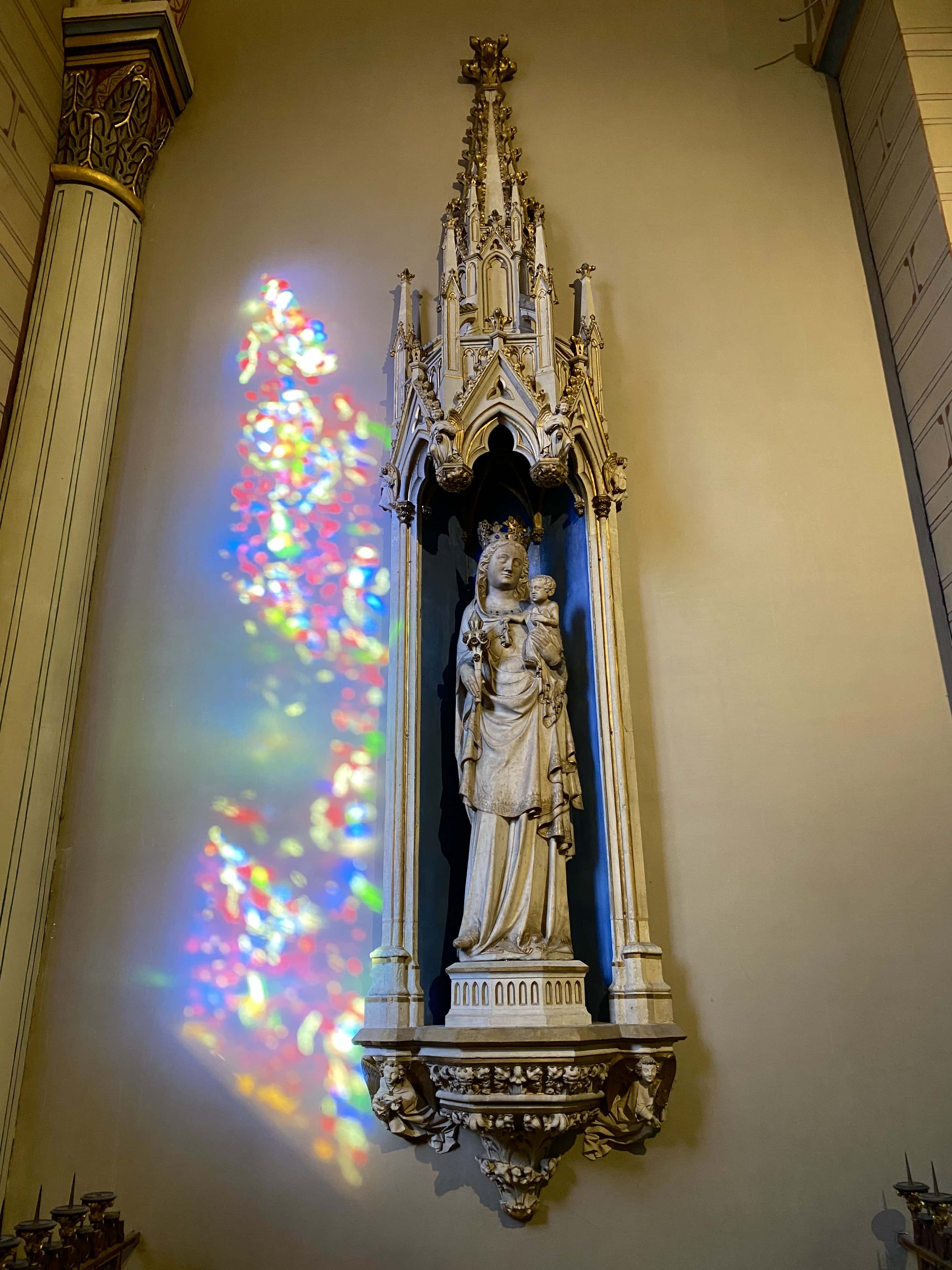
Within virtually all churches, if the sun shines through their stained glass windows, this same light phenomenon happens. A perfect example is the picture above from the Abbey of Saint Germain des Prés in Paris.
The Devil
On the left, as you enter the church, the infamous Devil kneels under the weight of supporting the Holy Water Stoup, adorned with four Angels and the inscription “By this sign you shall overcome him”; below, two Basilisks (or salamanders, as Basilisks have wings) look toward a round red monogram with BS on it. In Issue 10 [April 2024] of the magazine, an in-depth article will explain why Saunière incorporated this Devil into his church. “Kneeling is a gesture that is not only associated with Christianity but also holds great significance in the study of Christology.” This magazine will divulge the possible involvement of Abbé Béranger Saunière and his brother Alfred Saunière in various societies and the spread of such notions by some esoteric circles. We also divulge ‘IF’ the church of Rennes-le-Château was a Freemasonic Rose-Croix Chapter! More importantly, we bring you the high-level secret teachings of Abbé Béranger Saunière within his church at Rennes-le-Château, which will continue in Issue 11 [August 2024] of the Templarkey magazine.
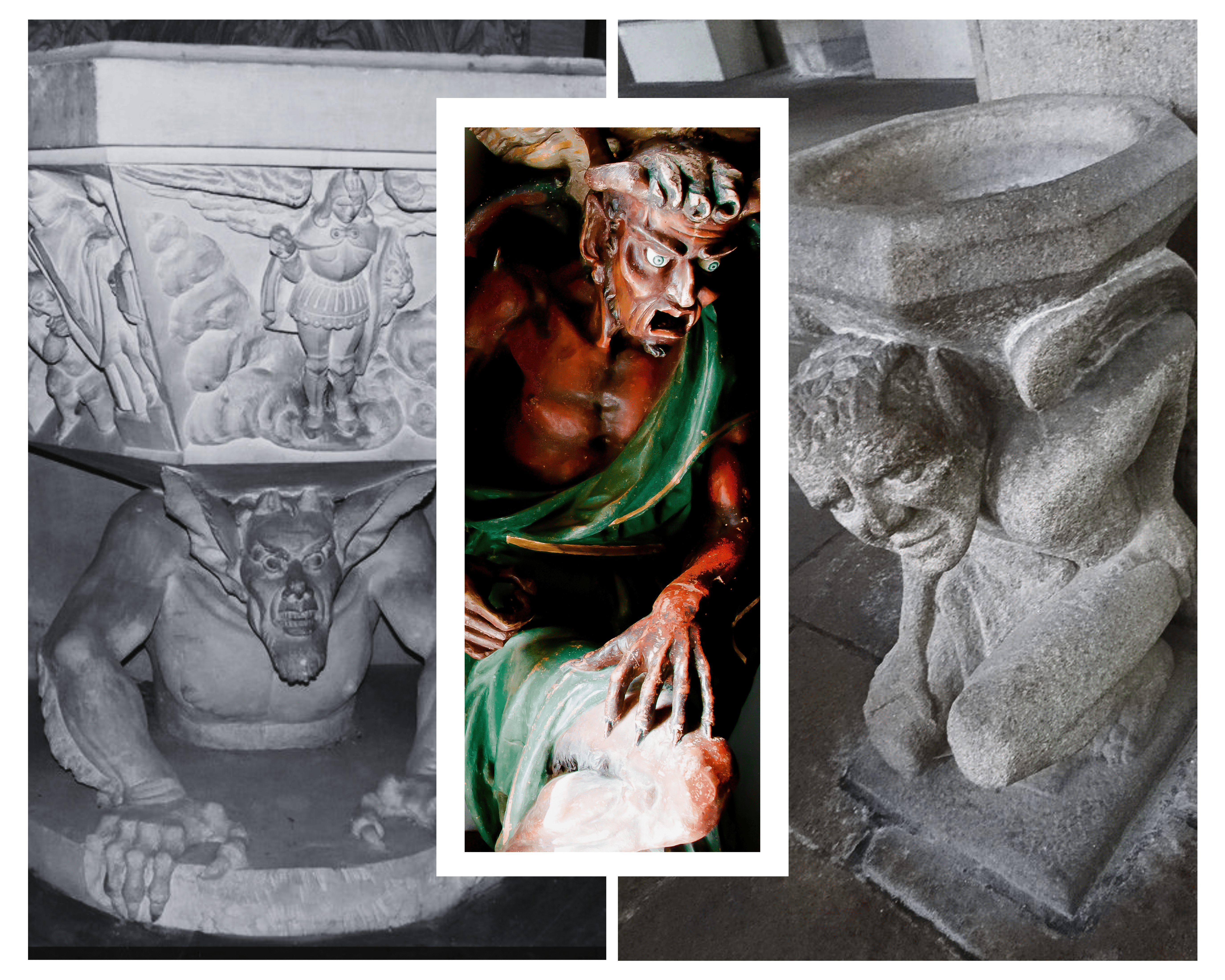
Masonic Pavement & The Stations of the Cross
Some researchers and Freemasons unfamiliar with the furnishings and theological interpretations of a Roman Catholic Church consider the devout Catholic Saunière’s rebuilding and design of the church at Rennes-le-Château unique. However, the church’s style is called the ‘Art de Saint-Sulpice’ or ‘suspicion style’ (this style is described as realistic, detailed, soft, sentimental, feminine, and ornamental). Saunière used the catalogue by the factory Joseph Giscard to purchase the ‘suspicion style’ statues and other items such as The Stations of the Cross. This factory was founded in 1855 by Jean-Baptiste Giscard, and at the height of the company, it employed around fifty workers. This factory supplied furniture for religious buildings in the region, private mansions and “Toulouse” houses.
Freemasons also believe the black-and-white checkered floor of the church is a Masonic one. However, the black-and-white church floor existed before the first Freemason lodges, and most of what is seen in the Masonic lodge originates from Roman Catholicism. The church’s black-and-white floor was originally just white, but it was changed in the 1960s to what we see today. An article in the Independent cites the historian Jean-Jacques Bedu. Also, Jean-Jacques Bedu is featured in the book Les énigmes de l’histoire de France, in the chapter XVII. Rennes-le-Château: La faute de l’abbé Saunière, 2021, Perrin.
Within this book, Jean-Jacques Bedu also explains how Saunière solicited donations and published advertisements in religious magazines throughout France to sell his masses. The business of selling masses by Saunière became so successful that he could not fulfil all the orders he received. “He could receive up to 400 a day when he could only legally say three a day,” explains Jean-Jacques Bedu. According to Rennes researchers, various Stations of the Cross were purposely adjusted by Saunière. Pierre Plantard infers that Saunière depicts an ancient Roman General’s tomb referred to on the 14th station of the Cross. In Issue 11 [August 2024] of the Templarkey magazine, we include photos of all the Stations of the Cross and similar Stations of the Cross from other churches.
The Infamous Bas-relief
Many research why Saunière used the scene depicted and the meaning behind this particular Bas-relief. An in-depth article regarding the Gnostic sense behind this feature will be published in Issue 11 [August 2024] of Templarkey magazine, which also continues with the teachings of Abbé Béranger Saunière.
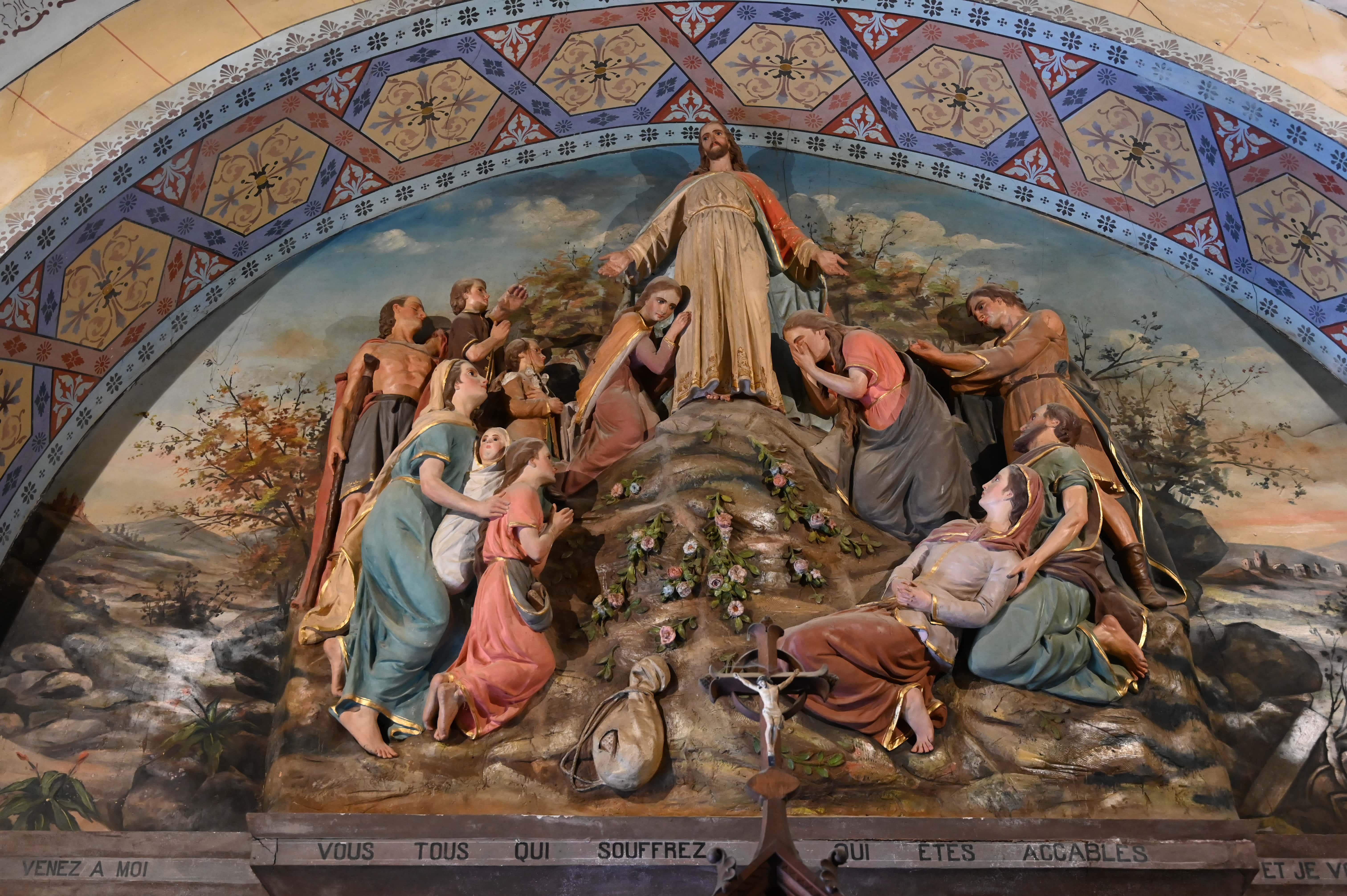 As for the Bas-relief, the biblical verse below was taken from Augustine’s Sermons 164:6, based on Matthew 11:28. Augustine was philosophying regarding the ‘Sermon on the Mount’, where Jesus Christ gave the Beatitudes. Later, when Jesus continued his journey, he continued his philosophical life lessons and the instruction of the Ministry of the Twelve Disciples. He then instructs on the non-repentant. Hence, the importance of the ‘Repentant Sinner’ Mary Magdalene within a church such as the one at Rennes. Besides the Mass, the primary role of a priest such as Saunière was to offer confession and repentance of sins.
As for the Bas-relief, the biblical verse below was taken from Augustine’s Sermons 164:6, based on Matthew 11:28. Augustine was philosophying regarding the ‘Sermon on the Mount’, where Jesus Christ gave the Beatitudes. Later, when Jesus continued his journey, he continued his philosophical life lessons and the instruction of the Ministry of the Twelve Disciples. He then instructs on the non-repentant. Hence, the importance of the ‘Repentant Sinner’ Mary Magdalene within a church such as the one at Rennes. Besides the Mass, the primary role of a priest such as Saunière was to offer confession and repentance of sins.
The Bas-relief says:
“Venez à moi vous tous qui souffrez et qui êtes accablés et je vous soulagerai”.
The Bas-relief in English says:
“Come to me all you who suffer and are burdened, and I will relieve you”.
Saint Augustine:
“Venez à moi, vous tous qui êtes chargés et accablés, et je vous soulagerai”.
Saint Augustine in English:
“Come to me,” he says, “all you who labour and are overburdened, and I will refresh you (Mt 11:28).
Matthew 11:28:
Jesus said, “Come to me, all you who are weary and burdened, and I will give you rest”.
The bas‑relief below the altar
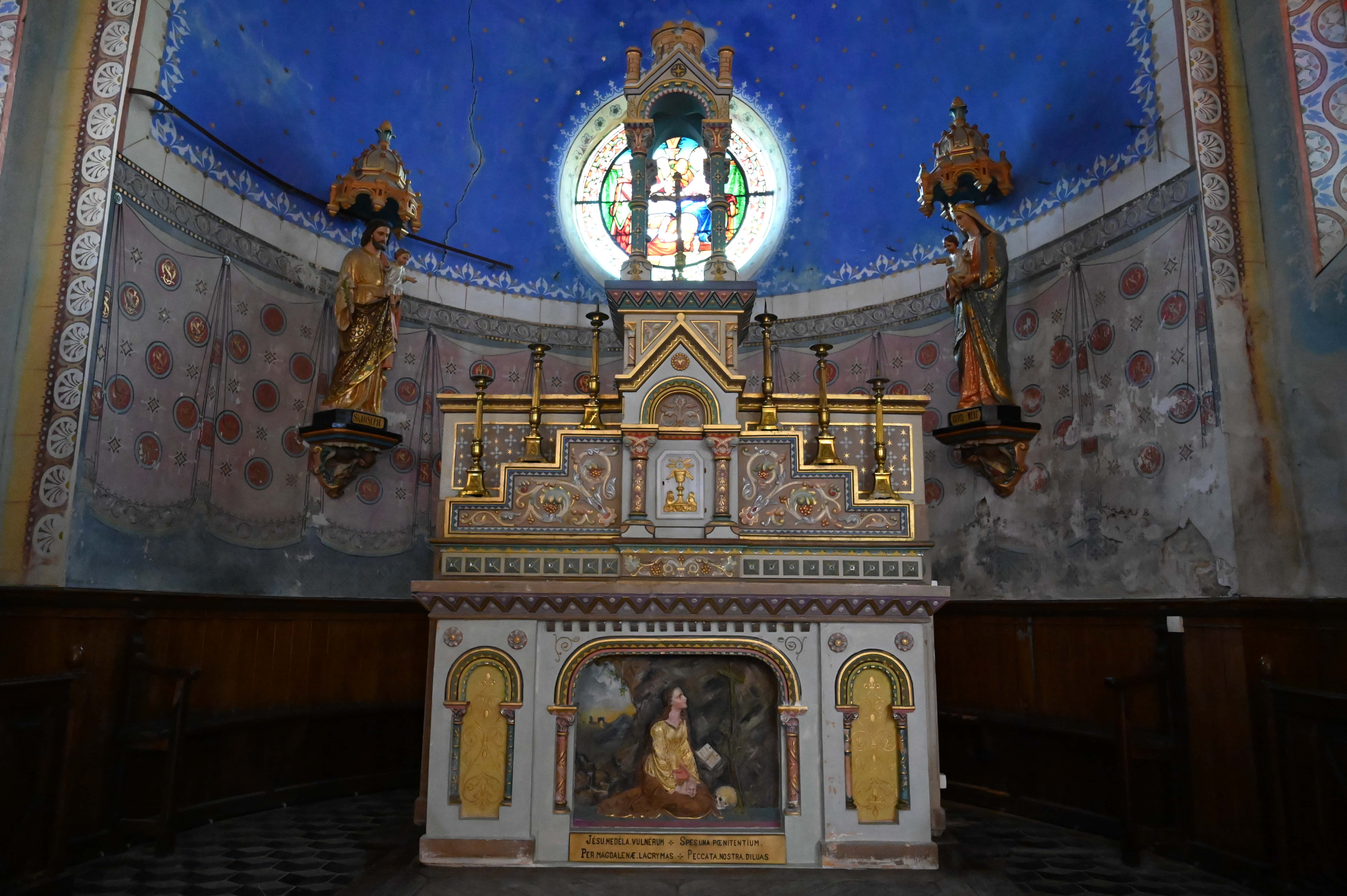 The bas‑relief of Mary Magdalene seen below the altar in the church is not uncommon within chapels dedicated to Mary Magdalene, such as various Penitent Chapels. See the picture below of one such altar.
The bas‑relief of Mary Magdalene seen below the altar in the church is not uncommon within chapels dedicated to Mary Magdalene, such as various Penitent Chapels. See the picture below of one such altar.
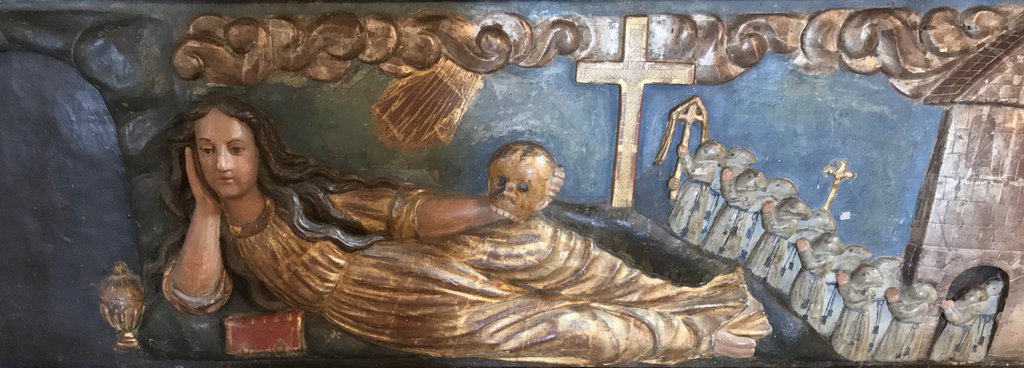
The Priory of Sion, Parchments, and the Tombstone
The village of Rennes-le-Château is known for the various cryptic messages and symbols that have sparked the curiosity of treasure hunters, historians, and conspiracy theorists alike. The mystery surrounding this small French town has captivated the imagination of many, with its alleged connections to Templar secrets, hidden treasures, and coded messages.
Pierre Plantard
In the mid-1950s, Pierre Plantard meets Noël Corbu; he tells Plantard the strange story of Saunière and how his money came from a treasure discovered in the region based on indications in parchments found inside one of the pillars of the church during renovation work. However, the story of the treasure was only a rumour invented by Noël Corbu to attract customers to the restaurant he had opened in the villa. Shortly after meeting Noël Corbu, Pierre Plantard began to forge a myth of his own. In the mid-1960s, several mysterious documents were deposited at the Bibliothèque Nationale in Paris; they were brought together under the title and a pseudonym, Les Dossiers secrets d’Henri Lobineau, “The Secret Dossiers of Henri Lobineau”.
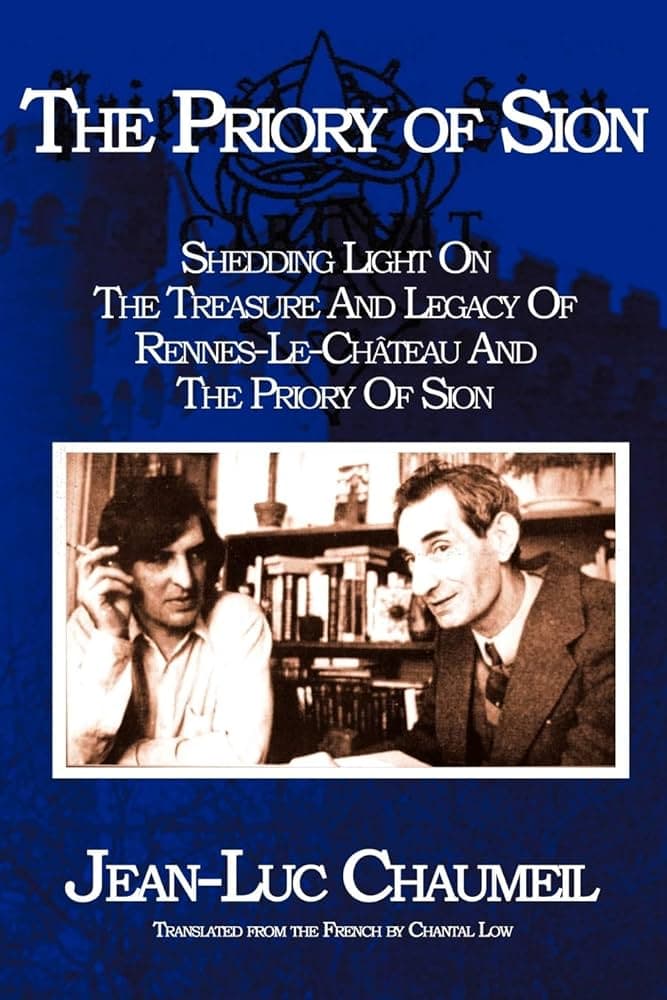 In June 1956, Pierre Plantard founded the Prieuré de Sion [Priory of Sion] with a few close friends; its headquarters were in Annemasse, near Geneva. Plantard (a Freemason Grand Orient de France in the lodge L’Avenir du Chablais in Ambilly) made himself Grand Master of this new order. There is no historical mention of any Priory of Sion before this date.
In June 1956, Pierre Plantard founded the Prieuré de Sion [Priory of Sion] with a few close friends; its headquarters were in Annemasse, near Geneva. Plantard (a Freemason Grand Orient de France in the lodge L’Avenir du Chablais in Ambilly) made himself Grand Master of this new order. There is no historical mention of any Priory of Sion before this date.
According to Jean-Luc-Chaumeil, “In the minds of its founders, Sion did not refer to Jerusalem but to Mount Sion, located very close to Geneva”. Read more regarding the Priory of Sion from Jean-Luc-Chaumeil in his book, Rennes-le-Chateau – Gisors – Le Testament du Prieuré de Sion. Le Crépuscule d’une Ténébreuse Affaire (Villeneuve de la Raho: Pégase, 2006). It was also translated into English and published by Avalonia Books entitled The Priory of Sion: Shedding Light On The Treasure And Legacy Of Rennes-le-Château And The Priory of Sion.
The downfall of Pierre Plantard
Plantard had been in prison twice. For the first time at the end of the Second World War, he was convicted for deeds to create associations without authorization. In 1953, the Court of Saint-Julien-en-Genevois also sentenced him to 6 months. Years later, during the Pechiney-Triangle Affair investigation, Plantard was back in front of the law. Judge Jean-Pierre learned that millionaire Roger-Patrice Pelat might have been the Priory of Sion’s Grand Master. Pelat’s name had been on Plantard’s list of grand masters since 1989. Pelat died in 1989 while facing insider trading charges. Plantard included him as the most recent Grand Master of the Priory of Sion by using his name as an “initiate” – a common practice of Plantard.
Plantard claimed that Roger-Patrice Pelat was a Grand Master in a Priory of Sion pamphlet on March 8 1989. He made the same claim again in a 1990 issue of Vaincre, the revived publication of Alpha Galates. Alpha Galates was a pseudo-chivalric order created by Plantard in Vichy, France, to support the “National Revolution”.
Roger-Patrice Pelat, a friend of French President Mitterrand, was involved in a scandal with Prime Minister Bérégovoy. Judge Jean-Pierre searched Plantard’s home, revealing fake documents, including those claiming Pierre Plantard was France’s true king. During the court trial, Plantard confessed in his sworn testimony to having fabricated everything, including Pelat’s supposed connection to the Priory of Sion. The Pelat family threatened legal action against him, which led to his disappearance to his home in southern France.
For further reading:
Les Cahiers de Rennes-le-Château Nr IX, page 59, Éditions Bélisane, 1989.
Jean-Jacques Bedu, Les sources secrètes du Da Vinci Code, Editions du Rocher, 2005.
Philippe Laprévôte, Note sur l’actualité du Prieuré de Sion, in: Politica Hermetica, Nr. 10 (1996), pp. 140–151.
Pierre Plantard, Geneviève Zaepfell et les Alpha-Galates, by Laurent Octonovo, in: Actes du Colloque d’Études & de Recherches sur Rennes-le-Château 2006, Oeil-du-Sphinx.
Gérard de Sède
One of the key figures regarding the mythological treasure linked to the church of Rennes-le-château is Émile Hoffet. Gérard de Sède claimed Émile Hoffet had known the French freemason and occultist Georges Monti, also known as Comte Israël Monti and Marcus Vella.
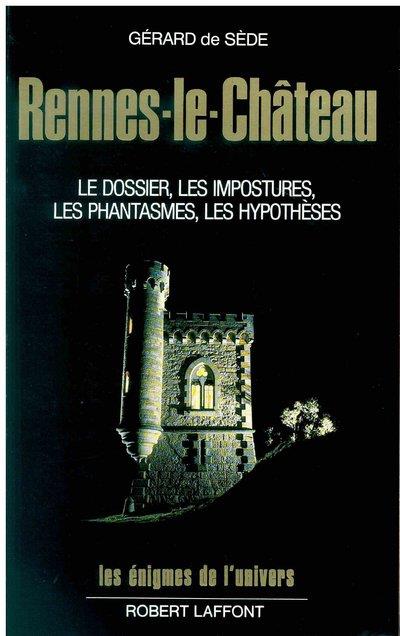 According to de Sède, Monti founded the original order of Alpha-Galates sometime in 1934; de Sède also alleged Monti was a private secretary to Joséphin Péladan. See Gérard de Sède in his ‘Fantastic Realism’ book, Rennes-le-Château: le dossier, les impostures, les phantasmes, les hypothèses (Paris: Robert Laffont, Les Énigmes de l’univers, 1988). For an explanation regarding the type of literature attached to the myths surrounding Rennes-le-Château, see our dedicated article in Issue 3 [April 2022] of the Templarkey magazine, as it is a must-read to comprehend the surrealist and ‘Fantastic Realism’ writers linked to esoteric books.
According to de Sède, Monti founded the original order of Alpha-Galates sometime in 1934; de Sède also alleged Monti was a private secretary to Joséphin Péladan. See Gérard de Sède in his ‘Fantastic Realism’ book, Rennes-le-Château: le dossier, les impostures, les phantasmes, les hypothèses (Paris: Robert Laffont, Les Énigmes de l’univers, 1988). For an explanation regarding the type of literature attached to the myths surrounding Rennes-le-Château, see our dedicated article in Issue 3 [April 2022] of the Templarkey magazine, as it is a must-read to comprehend the surrealist and ‘Fantastic Realism’ writers linked to esoteric books.
Joséphin Péladan wrote an alleged dedication to Monti in the 1890 edition of his book, Coeur En Peine: Commémoration Du Chevalier Adrien Péladan. (To Georges Monti. “It is in tradition that souls in pain will find peace, and it is in the defence of tradition that noble spirits must prove themselves to be faithful and valiant”, Péladan). The dedication is more than spurious since Monti would only have been ten years old at that time. For an explanation regarding more of the myths surrounding Rennes, see our dedicated article in Issue 10 [April 2024] of the Templarkey magazine.
Philippe de Chérisey
Philippe Louis Henri Marie, Marquis de Chérisey February 13 1923–July 17 1985. He is mainly known for creating the counterfeit parchments in the book L’Or de Rennes, published in 1967 by Gérard de Sède. Researchers describe in detail how de Chérisey used original Saunière material and homemade items to make believable documents. To understand more about the methods by which to decode them is in his manuscript “Pierre et Papier” (1970s); published in Rennes-le-Château -Gisors- Le Testament du Prieuré de Sion, le crépuscule d’une ténébreuse af faire, by Jean-Luc Chaumeil, Editions Pégase, Villeneuve de La Raho 2006. This book is translated into English, The Priory of Sion: Shedding Light on The Treasure and Legacy of Rennes-le-Château and the Priory of Sion, London: Avalonia, 2010).
The Mysterious Parchments
One of the most infamous elements of the Rennes-le-Château mystery is the proposed discovery of parchments by Saunière. Noël Corbu began circulating these stories that, while renovating his church in 1892, Saunière had discovered “parchments” connected with the treasure of Blanche of Castile and that he then found the treasure of Blanche.
These parchments contained cryptic messages and references to a hidden treasure. Some believe that these parchments hold clues to the location of an actual physical treasure. In contrast, others argue that they may represent symbolic or metaphorical treasures related to esoteric knowledge or spiritual enlightenment.
There were four parchments altogether, two of which were reproduced in Gérard de Sède’s forthcoming book (their contents were described in this 1965 document) and the other two containing genealogies made by the Abbé Bigou (running from 1548 to 1789) and Henri Lobineau (running from 1780 to 1915).
Small Parchment
The so-called Small Parchment, in the picture below, references the parable of Jesus picking ears of corn on the Sabbath. Copied from The Codex Bezae, also known as Codex D, is an ancient Greek-Latin manuscript dating back to the 5th century CE and contains both the Gospels and Acts of the Apostles, combining the three versions of the Gospels found in Luke 6: 1-5, Matthew 12: 1-8, and Mark 2: 23-28.
The Great Parchment
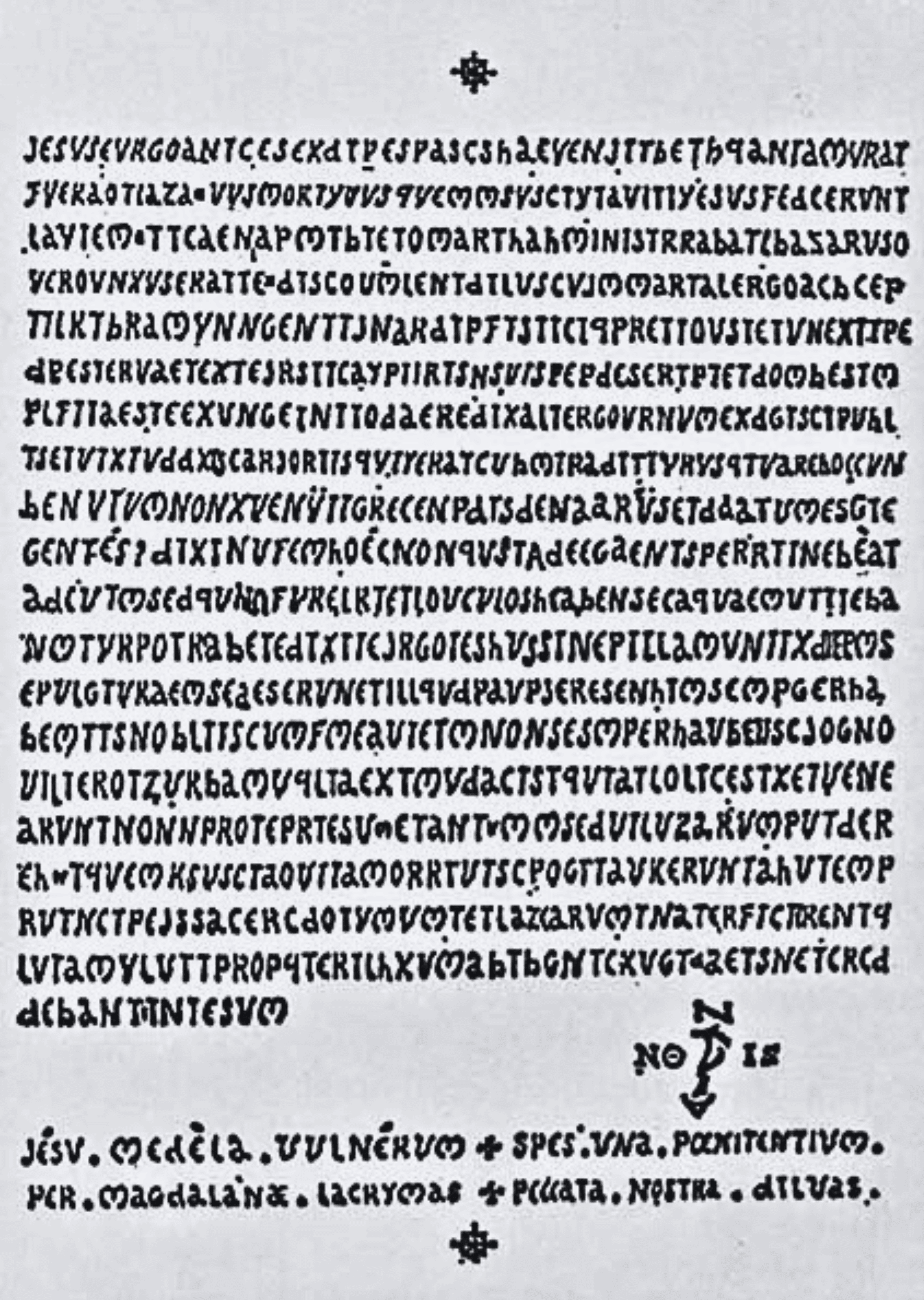 One of the parchments, known as the Great Parchment due to its longer text, was first made accessible to the general public by Gérard De Sède in the pages of his book L’Or de Rennes: ou la Vie insolite de Bérenger Saunière, curé de Rennes-le-Château 1967, Publisher, Julliard.
One of the parchments, known as the Great Parchment due to its longer text, was first made accessible to the general public by Gérard De Sède in the pages of his book L’Or de Rennes: ou la Vie insolite de Bérenger Saunière, curé de Rennes-le-Château 1967, Publisher, Julliard.
 In English: The Gold of Rennes: or the unusual life of Berenger Saunière, the priest of Rennes-le-Château. The book shown is a hardback 1968 version of this book.
In English: The Gold of Rennes: or the unusual life of Berenger Saunière, the priest of Rennes-le-Château. The book shown is a hardback 1968 version of this book.
“The so-called manuscripts presented by Gérard de Sède in this book were copies; the originals were fabricated in 1961 by Marquis Philippe de Chérisey and deposited in May 1962 with a solicitor, Maître Boccon-Gibod.
Bergere pas de tentation, que Poussin Teniers gardent la clef, Pax DCLXXX1. Par la croix et ce cheval de dieu, j’acheve ce daemon de gardien a midi. Pommes Bleues.
In English: Shepherdess no temptation, that Poussin Teniers hold the key, Peace 681. By the cross and this horse of God, I complete this Demon Guardian at midday, Blue Apples.
The Tombstone
Abbé Antoine Bigou allegedly commissioned the tombstone of Marie de Negre to conceal a great secret. The only evidence of this tombstone is a drawing in ‘Bulletin de la Société d’Ètudes Scientifiques de l’Aude’, volume XVII, 1906, page 101. There are replicas in the village Museum.
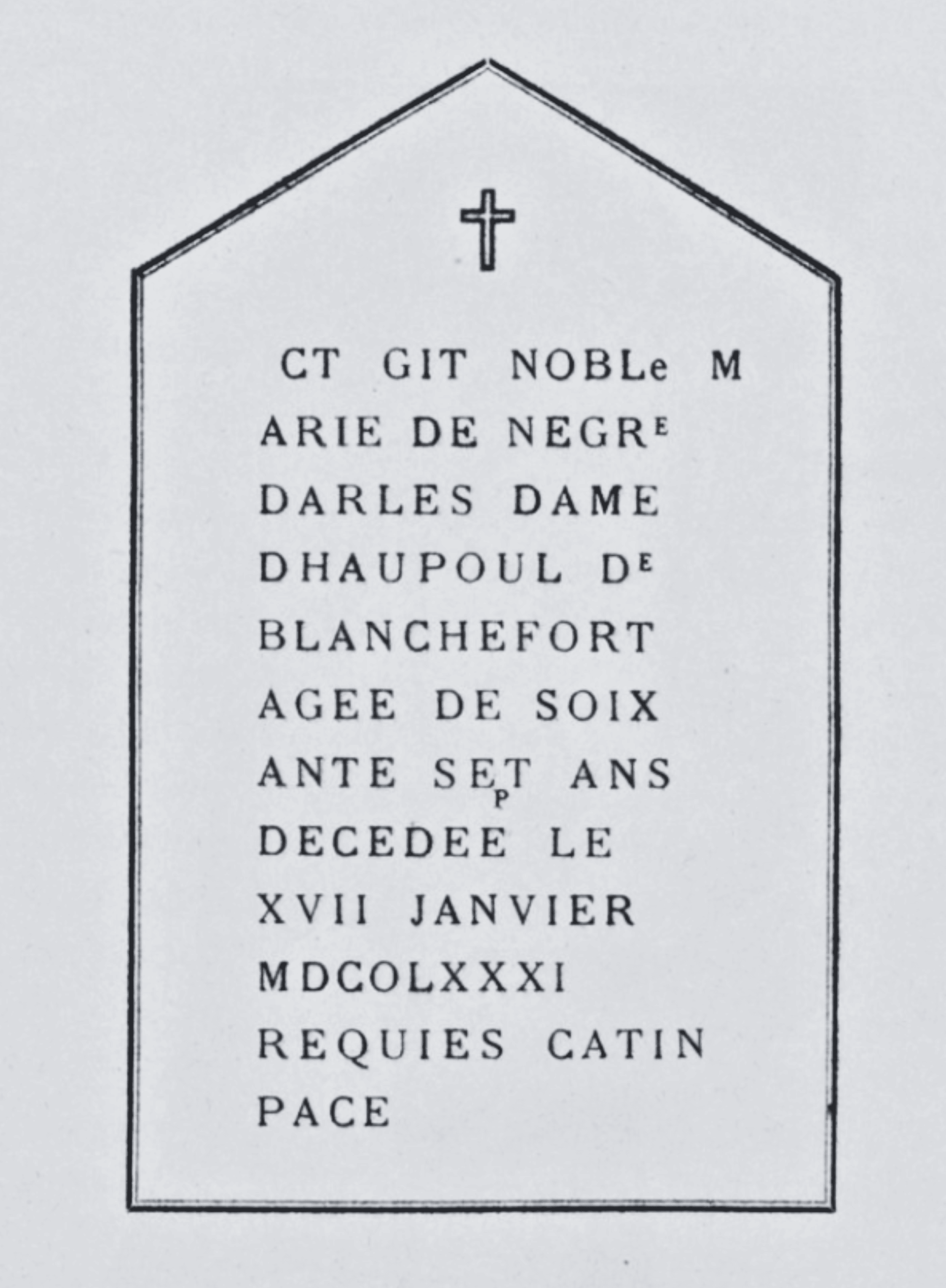 A 1965 Priory of Sion document stated Abbé Antoine Bigou, one of Saunière’s predecessor curés at Rennes-le-Château, hid the parchments in 1790 in the hollow pillar that supported the church altar after finding out about the secret of Rennes-le-Château on January 17 1781 at the deathbed of Marie de Negri d’Ables, Marquise d’Hautpoul-Blanchefort.
A 1965 Priory of Sion document stated Abbé Antoine Bigou, one of Saunière’s predecessor curés at Rennes-le-Château, hid the parchments in 1790 in the hollow pillar that supported the church altar after finding out about the secret of Rennes-le-Château on January 17 1781 at the deathbed of Marie de Negri d’Ables, Marquise d’Hautpoul-Blanchefort.
Marie de Blanchefort, also known as Marie de Négri d’Ables and Countess Hautpoul de Blanchefort, was the supposed wife of François d’Hautpoul, Marquis de Blanchefort and Lord of Rennes. Very little is known of them regarding Rennes-le-Château other than non-historical Wikipedia references.
However, much is known about the Hautpoul family, who originally lived in Mazamet in the Tarn region of France. According to non-historical sources, Marie lived from 1714 to 1781, and François lived from 1689 to 1753. Philippe de Chérisey used her epitaph (seen in the picture) as a partial template for the hidden message he created in his large parchment in the early 1960s.
 An additional tome stone epitaph, possibly the lower part of the tombstone, was added to complete a puzzle. These tombstones have never been seen, except for the upper part by Elie Tisseyre in 1905. He drew a picture of it for his article titled “Excursion on June 25, 1905, to Rennes-le-Château” (first published in the ‘Bulletin de la Société d’Ètudes Scientifiques de l’Aude’ volume XVII, 1906) and a supposedly second time in a brochure version of the article published in 1931, deposited in the Municipal Library of Carcassonne.
An additional tome stone epitaph, possibly the lower part of the tombstone, was added to complete a puzzle. These tombstones have never been seen, except for the upper part by Elie Tisseyre in 1905. He drew a picture of it for his article titled “Excursion on June 25, 1905, to Rennes-le-Château” (first published in the ‘Bulletin de la Société d’Ètudes Scientifiques de l’Aude’ volume XVII, 1906) and a supposedly second time in a brochure version of the article published in 1931, deposited in the Municipal Library of Carcassonne.
The lower part (never seen or documented before the 1960s) included the famous Et in Arcadia Ego invention. This lower tombstone was first introduced in July 1962 on a radio programme by Noël Corbu; only the REDDIS REGIS CELLIS ARCIS components were referred to, without the extra words either side mentioned. Initially, Noël Corbu insisted it belonged to the grave of Marie de Negri d’Ables, Countess of Hautpoul-Blanchefort, and that Ernest Cros (1857-1946) had worked on it. Philippe de Chérisey later revised it by adding extra components.
The curious symbols
In addition to the mysterious parchments, Rennes-le-Château is also adorned with various curious symbols and motifs. From enigmatic inscriptions on gravestones to features within the village church (Église Sainte Marie-Madeleine), these symbols have fueled speculation about their potential meanings and connections to hidden truths. Some researchers have suggested that these symbols may be linked to alchemical or mystical traditions, while others propose more practical explanations related to regional folklore and historical context.
The special Station of the Cross
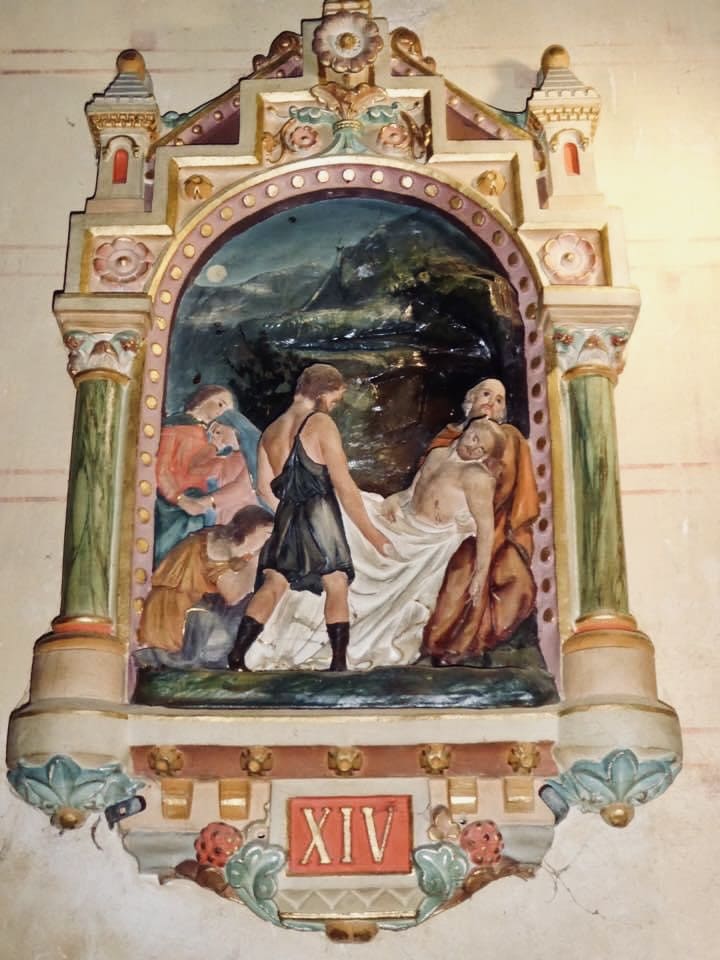
Station 14 shows three people carrying Jesus’s body after he’s taken down from the cross, and according to some researchers, this proves Jesus survived the Crucifixion and was being carried out of his tome alive. However, according to the religious scholar Craig Evans: “The moon was added to the picture mistakenly by someone who thought that Jesus’s body was taken down when it was already night. But to infer from that some secret, some special knowledge that suggests that Jesus was taken down from the cross still living is very far-fetched”. We could add more to this article, but we will add more details in a future magazine article.
Scanning for Gold
In 1958, Robert Charroux (founder of Club des chercheurs du Trésors in 1951) unsuccessfully scanned Rennes-le-Château for gold and jewels using a metal detector with his wife Yvette.
Deciphering the Rennes enigma
Despite decades of speculation and investigation, the true meaning behind Rennes cryptic messages and symbols remains elusive. Scholars, amateur sleuths, and enthusiasts have attempted to decipher these mysteries using historical research, code-breaking techniques, and creative interpretations. However, no definitive answers have been uncovered, leaving Rennes-Le-Chateau as an enduring enigma that intrigues those fascinated by tales of hidden knowledge and untold riches.
As visitors explore this picturesque village in the French countryside, they are greeted with an array of puzzles waiting to be unravelled – from obscure inscriptions etched into stone walls to enigmatic motifs adorning local chapels. Whether these mysteries will ever be fully decoded or if they will continue fueling speculation for generations is a question yet unanswered in this modern age.
Controversies and Conspiracy Theories
The enigmatic and mysterious history of Rennes-le-Château has sparked numerous controversies and conspiracy theories over the years. From hidden treasures to secret Masonic societies, the small village in southern France continues to capture the imagination of many.
One of the most enduring controversies is the claim that Saunière discovered a considerable wealth hidden within the church during renovations in the late 19th century. Some believe this discovery is connected to a hidden treasure, possibly linked to the Knights Templar or other ancient secrets. This theory has led to speculation about what Saunière found and how it may be connected to more significant historical events.
Another controversial aspect of Rennes-le-Château is the presence of cryptic messages and symbols scattered throughout the area. From coded inscriptions on tombstones to enigmatic paintings in local churches, these symbols have fueled speculation about hidden meanings and secret messages left behind by past inhabitants. Some believe these symbols hold clues to uncovering long-buried truths about the history and significance of Rennes-le-Château.
Furthermore, conspiracy theories abound regarding the possible involvement of Masonic and influential organizations in the mysteries of Rennes-le-Château. Some believe that these groups, from the Knights Templar to the Priory of Sion, have shaped the historical narrative and modern perception of Rennes-le-Château. These theories often tie into narratives about ancient knowledge, esoteric traditions, and hidden power structures.
The Controversies and Conspiracy Theories Surrounding Rennes-Le-Château
- The controversy surrounding Abbé Saunière’s sudden wealth
- The presence of cryptic messages and symbols
- Conspiracy theories involving secret societies and influential organizations
Rennes-Le-Château Today
Rennes-Le-Château has become a popular tourist destination in recent years, attracting visitors from all over the world drawn to the mysteries and legends surrounding this enigmatic place. The small village, located in the Languedoc region of France, has gained notoriety due to its association with the story of hidden treasure and enigmatic characters, particularly Bérenger Saunière, Abbe Henri Boudet, and Marie Dénarnaud.
For tourists and enthusiasts of the Rennes-le-Château mystery, there are several attractions and sites to visit. These include:
- The Church of Saint Mary Magdalene: This is where Bérenger Saunière served as the parish priest and where Saunière supposedly discovered hidden documents that led to his sudden wealth. The church’s interior is filled with mysterious symbols and cryptic messages that continue to intrigue visitors.
- The Villa Bethania: This is the former residence of Bérenger Saunière, which he transformed into a lavish estate using his newfound wealth. Visitors can explore the opulent decor and try unravelling the hidden secrets within its walls.
- The Rennes-le-Château Museum: This museum offers an in-depth exploration of the history and mysteries surrounding Rennes-le-Château. It showcases artefacts, documents, and exhibits related to key figures associated with the enigma.
Furthermore, various tours are available for those looking to delve deeper into the history and legends of Rennes-le-Château. These guided tours often provide insights into the cryptic messages found in the area’s landmarks.
Despite its popularity as a tourist destination, Rennes-Le-Château remains shrouded in mystery and controversy. Numerous conspiracy theories have emerged over the years regarding the alleged hidden treasure and secrets buried within this picturesque village. As such, it remains an ongoing mystery that captures the imagination of visitors from around the globe.
For the late creation regarding St Mary Magdalene in Rennes-le-Château, you can read our website articles, Saintes-Maries-de-la-Mer, Saint Sara La Kali The Rare and Cultus of Mary Magdalene, Sara & Jesus, The 1st Sacred Pilgrimage.
Conclusion
In conclusion, Rennes-Le-Château remains, for some, an endless enigma filled with mysteries and unanswered questions. The legends of hidden treasure, enigmatic priests, and cryptic messages continue to capture the imagination of people around the world. Despite the continuous efforts of numerous researchers and enthusiasts, they do not comprehend the true nature behind the secrets linked to this small French village.
While there is much speculation surrounding the possibility that Bérenger Saunière discovered a treasure of some sort, little is known about the activities of Saunière and his brother, Alfred. For many, it seems likely Saunière would find a treasure of some kind; however, some reports suggest that the brothers may have been involved in the illegal trade of items from local churches. Specifically, it is said that the Saunière brothers sold church artefacts on the black market, a practice not uncommon in the region during the late 19th and early 20th centuries. While the exact nature and extent of their activities remain a mystery, it is clear that their actions were not in line with the principles and values of the Catholic Church. It is worth noting that the sale of church artefacts is considered a serious offence and is punishable by law in many countries.
The stories of Bérenger Saunière, Abbe Henri Boudet, and Marie Dénarnaud only add to the intrigue surrounding Rennes-Le-Château. Their lives are shrouded in mystery, and their connections to the alleged treasure have sparked numerous theories and speculations. The cryptic symbols and messages throughout the village have fueled countless interpretations and attempts at decoding, yet the truth remains just out of reach. Even today, Rennes-Le-Château continues to draw visitors from far and wide. The allure of its mysterious history has turned it into a popular tourist destination. While some may come in search of answers, many leave with even more questions than before. The conspiracy theories surrounding Rennes-Le-Château serve to keep its mystery alive for generations to come. As long as there are those who seek to uncover its secrets, the enigma of Rennes-Le-Château will endure.
Frequently Asked Questions
Is Rennes-Le-Château worth visiting?
Rennes-Le-Château is worth visiting, especially for mystery enthusiasts. The picturesque village, stunning landscape, and intriguing stories surrounding the area make it a compelling destination.
What Is the Mystery of Rennes-Le-Château?
The mystery of Rennes-Le-Château revolves around various theories and legends, including hidden treasure, secret societies, and supposed connections to religious artefacts or even the Holy Grail. The enigma has attracted attention from conspiracy theorists and historians alike.
How Long to Spend in the Area of Rennes-Le-Château?
To fully appreciate what Rennes-Le-Château has to offer, it is recommended that you spend at least 2-3 days in the local area. This will allow enough time to explore the other local historical sites, visit local attractions, savour the culinary delights, and immerse yourself in the unique atmosphere of this captivating destination.

